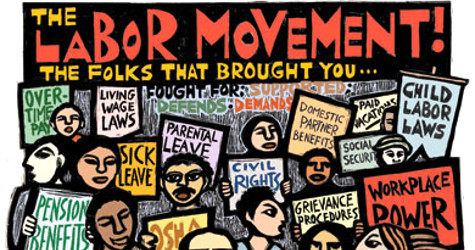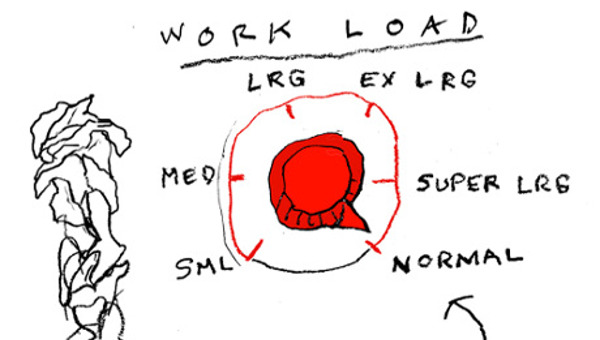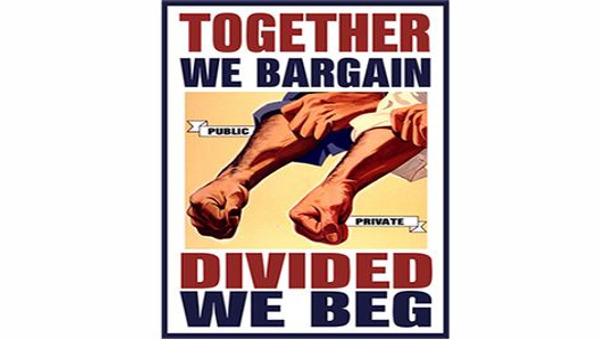Public Sector Unions and the Consultations for Austerity
Nearly six months have gone since the G20 Summit in Toronto when we supposedly entered what some have referred to as “permanent austerity” – the “new normal” of capitalist social relations. Whilst using the significant resources of the state to inject liquidity into markets and ensure corporate and banking profits, ruling classes simultaneously are cutting public services across the board, imposing user fees and letting public transit rot, and, in the specific case at hand, kicking labour’s ass while convincing the public bureaucracy that there is no alternative.

This austerity cannot be merely interpreted as a ‘shrinking’ of the state. Public sector workers are being asked to tighten their belts, for example, but the Canadian Security Intelligence Service (CSIS) is getting a big boost in funding, even after the debacle of the Toronto G20 summit and numerous reports of CSIS harassment of activists particularly within indigenous and Palestinian solidarity movements. Welfare and ‘special diet’ transfers and plans to expand public transit are being trimmed, yet new fighter planes that even military hawks are questioning are being ordered. The austerity agenda isn’t about big versus small government: it is about increasing the repressive and punitive aspects of governments and shrinking redistributive programmes and democratic gains. All things considered, the central agenda governments are pursuing is, as it were, ‘Saving Private Power.’
In Ontario (and, indeed, across Canada), public sector unions, against significant – if uncoordinated – rank and file dissent, have been in on/off consultations with the government. This has raised significant issues for trade unions and rank and file members. On the one hand, public sector unions have been attempting to act as responsible participants in a pluralistic public sphere, as ‘stakeholders’ responsibly negotiating with employers over wages and service provisions. On the other, the ‘consultations’ between the province and unions have been about austerity and how the cost of the crisis will be shared out amongst public sector employees and users of public services, rather than the financial and business sector that caused the crisis and that has massively gained economically from neoliberal policies. And behind all sorts of procedural manoeuvring, public sector union leaderships have often left their rank and file members in the dark – and very confused – over the negotiations.
A Legal Trap?
The wage restraint consultations between the Ontario government and public sector unions that has been going on since the release of the 2010 Budget suggests a trap may be set for organized labour. This trap has been put in place by the language of the Supreme Court of Canada (SCC) in its recent, although quite particular, recognition that the Canadian Charter of Rights and Freedoms protects from government intervention workers’ ability to organize and to collectively bargain. Since the Charter‘s enactment in 1982, the absence of any protection for labour rights was generally seen as a major limit and contradiction in setting a framework for modern liberal rights. The recent recognition of labour rights seemed as if it could be a straightforward labour victory. But it is now clear that governments might be able to engage in even more repressive restraint measures because, paradoxically, labour rights are now constitutionally enshrined via the Charter ruling.
Public sector unions in Ontario have been invited by the Ontario government to enter into “consultations” on wage restraint. A particular ‘legal trap’ is, however, set by the word ‘consultation’ especially if modified by the word ‘meaningful.’ This phrase – “meaningful consultation” – comes from the SCC, who took it from the International Labour Organization (ILO). This phrase is a trap because it allows the government to justify whatever sort of wage restraint measures they want as being consistent with labour rights because the measures come from a process that putatively respects consultation; and therefore the measures are ‘reasonable.’ This is true even if no agreement is reached as a result of the consultations, and the government unilaterally legislates wage freezes, contracting out of unionized positions, re-organization, or whatever else.
This peculiar ‘legal trap’ was created in a decision of the SCC called “BC Health Services” (cited as Health Services and Support – Facilities Subsector Bargaining Assn. v. British Columbia, [2007] 2 S.C.R. 39). In this decision, the SCC, perhaps in an attempt to remedy the contradiction of the exclusion of Canadian workers from the Charter, founded an even deeper contradiction because of the way the Court had to limit the recognition of labour rights in order to make it consistent with Canadian capitalism.
BC Health Services concerned restraint measures imposed by the BC government in the health care sector. Except for a quick phone call on the eve the legislation was passed, there was no consultation between the BC government and the unions who represented health care workers whose wages would be reduced and jobs would be subject to contracting out as a result of the legislation.
In their decision, the SCC found that section 2(d) of the Charter, which protected “freedom of association,” protected those workers against unilateral measures of that type. But the SCC also found that the right to collectively bargain only protects against: (1) substantive interference with the procedure of bargaining; (2) over important matters; and (3) in a way that does not respect the duty to bargain in good faith. All of (1), (2), and (3) must be applicable in order for a violation to be found. Thus, the right only guarantees a process. If the process is respected, and an agreement is attempted, even if the outcome is the unilateral imposition of restraint measures, there is no violation.
This right, as with all rights and freedoms in the Charter, is also subject to section 1 of the Charter, which has sometimes been called the ‘capitalism clause’ for the way it has been invoked, as it states that all rights and freedoms are subject to “reasonable limits.” Thus, even where legislation does (1), (2), and (3), it can still be saved by section 1 if it is a “reasonable limit.” This means, for example, legislation that violates the right in order to legislate measures concerning “essential services, vital state administration, clear deadlocks and national crisis” can be argued to be “reasonable” (at para. 108 of BC Health Services). The SCC’s list here is again taken from the ILO.
Throughout the decision, it is clear that the SCC’s concern is that all the BC government did to consult was that one phone call. The word “consultation” appears over and over in the decision. The SCC points out that when legislation unilaterally changes portions of collective agreements, even if “the changes substantially touch on collective bargaining, they will still not violate s. 2(d) if they preserve a process of consultation and good faith negotiation” (at para. 94). This is because if they preserve a process of consultation, then (3) will not be applicable – the process was respected.
Thus, if governments engage in a process of “meaningful consultation” before instituting restraint measures, this would go a long way to undermine any Charter challenge. This is the trap. Yet, even if public sector unions refuse to consult, the government still may cite that refusal as a justification in the preamble to their restraint legislation – they tried to preserve a process of consultation, but the union wouldn’t have it. So, either way the language of the SCC in giving a right to collectively bargain justifies the overwhelming limitation of that right. We saw this with the use of the phrase “clear deadlock” in both examples of the back to work legislation that forced Toronto Transit (TTC) workers and the CUPE 3903 workers back to work. This phrase is another trap taken from the SCC who took it from the ILO.
So, public sector unions are snookered: they have to bargain for restraint, because if they don’t it will just be legislated and insulated from any challenge either because the union refused to bargain, or because they did bargain. The only recourse is the strike. But this will seem increasingly ‘unreasonable’ to rank and file workers, if done during the life of collective agreement (even if terms of the agreement are imposed by legislation) the strike would be ‘illegal,’ and either way, ‘the government tried to consult!’ Furthermore, even with the strike, the SCC’s language also allows the government to justify back-to-work legislation. Organized labour is forced to accept insanity, or else be taken to be insane.
The Constitutionalization of Permanent Austerity
The institution of “permanent austerity” by governments in Canada is a political process. But it may be given some aid by the legalistic parameters for unions in Canada and the way that the constitutional recognition of labour rights has arrived. In Canada, constitutional recognition has come with the cost of making labour rights ‘reasonable,’ and thus limited. The right to collectively bargain only protects a process of consultation. This could then be used to justify the unilateral imposition of repressive restraint measures as being ‘reasonable,’ and therefore consistent with labour rights. Hence, restraint is a part of the ‘reasonable’ trade-off labour has to make in order to get rights. This is not only a neoliberal innovation. From the beginning of the provincial turn to austerity, Ontario provincial NDP leader Andrea Horwath has refused to condemn the wage freeze, adding that “workers will understand that they have to do their part as well.”1
Comparing the roles played by various public sector unions is an instructive exercise. The relative strength of different unions is less reflective, it seems, upon the willingness of the unions to fight the province, and more dependent, upon the specific trade or profession represented by the unions. At the start of consultations, CUPE-Ontario (Canadian Union of Public Employees) sent an official communiqué to its members announcing that CUPE would be entering consultations with the provincial government, and reassuring members that they wouldn’t stand for any “concessionary” wage freeze. CUPE’s statement is short, and to the point. Claiming that “everyone” is frustrated, the letter also suggests that “CUPE continues to do our best to present alternatives that will protect and strengthen public services.”2 But this falls quite short of opposing the consultations and conveys the hope that being “at the table” will somehow strengthen public services. And has been left quite unclear what steps CUPE will be taking to mobilize its membership, work with community organizations in fighting service cuts and to undertake education on the capitalist causes of the economic crisis and the public sector cuts. In other words, CUPE does nothing to convey the kind of political campaign it will undertake as opposed to its consultation tactics.
OPSEU’s (Ontario Public Service Employees Union) position has been even more accommodating toward the consultations process. The OPSEU leadership has limited involvement of some local presidents in the consultations, and particularly demands that the process be subject to democratic participation by members. Any strategies about bargaining tradeoffs between professionals and lower income members of the workforce have been left unclear, as this recalls the low-income-cut-off of the Bob Rae Social Contract of the 1990s. There has been hints about strategically pursuing non-monetary gains like protection against workplace violence and emphasizing the importance of protecting the lowest income workers. But where the OPSEU leadership is on any of this is quite unclear, nor is there any attempt to engage the membership systematically in how to oppose austerity and engage in defences of public sector services with user groups. And at the outset of a major period of public sector struggle in Ontario and Canada, there is the bizarre spectacle of NUPGE (National Union of Public and General Employees), OPSEU’s national affiliate, leaving the national labour federation.
In contrast, Ontario nurses, who have no legalized right-to-strike, may be in the best position vis-à-vis the wage freeze. As there have been scattered examples of arbitrators ignoring the provincial wage freezes, the Ontario Nurses Association (ONA) is poised to enter bargaining with the province in a position of strength. They could pursue a not insignificant settlement, allow the process to ‘drag out,’ and engage in a range of disruptive workplace tactics to break the wage freeze and concessions demands. The question is also how to relate such actions and strategies to the non-unionized nurses (one quarter of Ontario’s RNs) who have had their wages frozen. That would be a real test of challenging the Ontario government’s pursuit of ‘permanent austerity.’ The nurses have more public support than most unions. A slight to them – perhaps disruption of attempts to organize non-union nurses at Sick Kids Hospital and elsewhere, may be a spark that lights a larger blaze of resistance that the Dalton McGuinty government will have difficulty putting out.
Opposing the Consultations for Austerity
Of course, more than a few professionals in the public sector and unions buy into the legalistic ideology of liberal democracy and responsible trade unionism. Today, this is often under the belief that it will help protect public services. There may be some room to get the McGuinty government to increase some funding to key public services if the unions play ball. This will justify the liberal rhetoric of reasonableness and preserve the ideology of the neutrality of the law.
But in capitalism, with its formal separation of political relations and economic exploitation, the political sphere in which juridical decisions are made only appears to be neutral. Consultations between unions and government sustain the appearance of neutrality, but the very premise of consultations, such as those going on in Ontario over austerity, reveal the class biases of the austerity policies they are meant to help implement. This is the class reality of the law and its trap, which unions and workers need to be aware of.
In the public sector in the last few years, there have been a few significant strikes that have been militant and challenges to neoliberal policies. Two of these ended in back to work legislation. There is plenty of capacity, and even militancy, among and across the public sector to challenge the consultations over public sector austerity. It is certainly possible, particularly if the economic crisis takes another negative turn, that public sector workers might feel forced into the situation of taking to formally ‘illegal’ strikes to back up their demands for fair collective bargaining. This certainly has been the case across Europe, and there are more than a few precedents in Canada as well.
A first step toward building such a fight-back, however, is to demand that public sector unions keep away from austerity consultations, with the McGuinty government and other such processes across Canada. The next steps, of organization building and mounting a fight-back to preserve free collective bargaining in the public sector and the issue of who should be paying for the crisis. This effort can’t be limited to an isolated battle at a single workplace. Instead, it is a battle in which all public sector workers – and even public sector managers who want nothing to do with the wage freeze – unite across workplaces, across sectors, and across unions. It is clear that any anti-neoliberal exit to the economic crisis will depend upon public sector workers and unions using the power that they potentially have in new tactics and deployed to more militant ends. •
Endnotes
- Adam Radwanski, “Opposition flubs attack on McGuinty budget,” Globe and Mail, March 30, 2010.
- “Update to CUPE members re discussions with Ontario government,” September 10, 2010.





